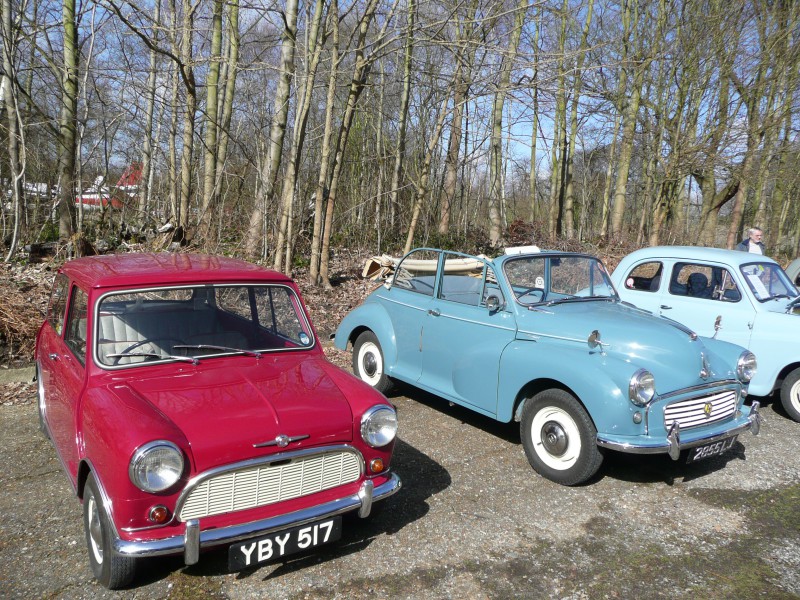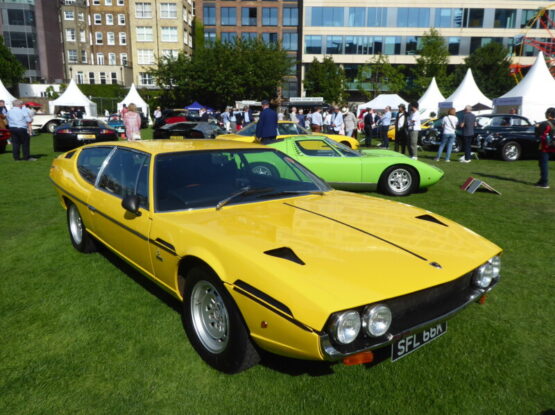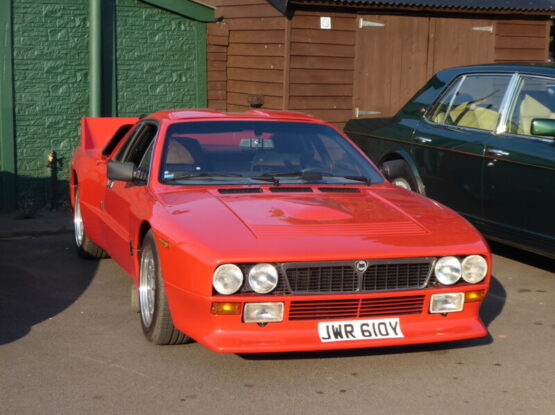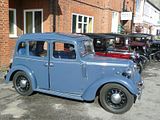 After spending a day inspecting all the latest offerings for the European market from a whole panapoly of different manufacturers, I followed this up with something of a wallow in nostalgia, just 2 days later, at the Austin-Morris Day held at the historic Brooklands site. I could scarcely believe my luck when my plane landed, and I could see just a lovely blue sky, and not even one wisp of cloud. Of course, by the time I had got out to my car, the clouds were starting to appear, but were still only small, so it looked clear that I could reasonably expect to enjoy some decent weather, and – perhaps more to the point – it was just possible that a few more owners would be tempted to fire up their prides and joy and bring them along.
After spending a day inspecting all the latest offerings for the European market from a whole panapoly of different manufacturers, I followed this up with something of a wallow in nostalgia, just 2 days later, at the Austin-Morris Day held at the historic Brooklands site. I could scarcely believe my luck when my plane landed, and I could see just a lovely blue sky, and not even one wisp of cloud. Of course, by the time I had got out to my car, the clouds were starting to appear, but were still only small, so it looked clear that I could reasonably expect to enjoy some decent weather, and – perhaps more to the point – it was just possible that a few more owners would be tempted to fire up their prides and joy and bring them along.
The format of the event is very simple: Austin and Morris vehicles of all ages come along, they park up and everyone wanders around to have look at the rest of the display. The site stewards try to keep similar cars in the same general area of the site, which works for a while – though not without a certain amount of frantic yelling at some drivers! – but that ceases to work when either a particular area runs out of space (far more Oxford and Cambridge cars turned up than the allotted area could accommodate), or when people move them around.One of the oldest cars on show was this Austin. I have no more details than to tell you it is an Austin.
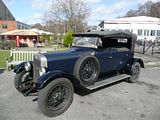 There were plenty of the Austin Seven based cars, as you would expect, as survivors of this little car are plentiful. They vary from the early 1922 cars to the last production models from the 1930s, and several of the sporting models. All of these are tiny cars indeed.
There were plenty of the Austin Seven based cars, as you would expect, as survivors of this little car are plentiful. They vary from the early 1922 cars to the last production models from the 1930s, and several of the sporting models. All of these are tiny cars indeed.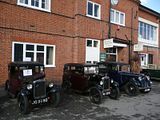
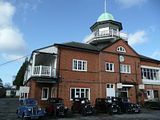

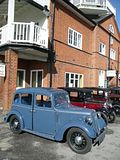
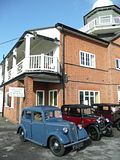
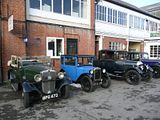

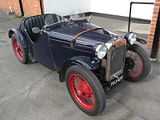

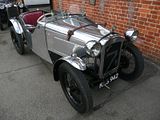 Successor to the Seven was the Eight, and a couple of these cars which straddled World War 2 were on show.
Successor to the Seven was the Eight, and a couple of these cars which straddled World War 2 were on show.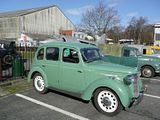
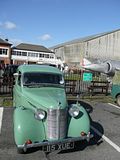 After the war, it took a while before new models appeared, and these came with the various “County” series, all of which bear the wonderful “Austin of England” badging on them. There were a couple of A40 Somersets (1951 – 1955) on show. Fitted with the 1250cc B series engine, these family cars were hardly a ball of fire even when they were new, but they provided family motoring to those lucky enough to be able to get a new car (which was not many people, as most of them went for export).
After the war, it took a while before new models appeared, and these came with the various “County” series, all of which bear the wonderful “Austin of England” badging on them. There were a couple of A40 Somersets (1951 – 1955) on show. Fitted with the 1250cc B series engine, these family cars were hardly a ball of fire even when they were new, but they provided family motoring to those lucky enough to be able to get a new car (which was not many people, as most of them went for export).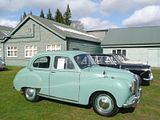
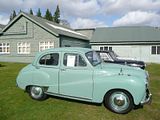
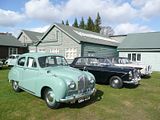
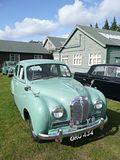 Big brother to the A40 was the A70 Hereford. When this car arrived, although the styling is very similar, I could immediately see the much larger frontal area which had to house a 2200cc 6 cylinder in-line engine, thus confirming it as a rare survivor of a model that sold in far smaller quantities. Many attendees (most of whom are far more steeped in Austin history than me, I would have to assume) seemed to think it was a Somerset, too.
Big brother to the A40 was the A70 Hereford. When this car arrived, although the styling is very similar, I could immediately see the much larger frontal area which had to house a 2200cc 6 cylinder in-line engine, thus confirming it as a rare survivor of a model that sold in far smaller quantities. Many attendees (most of whom are far more steeped in Austin history than me, I would have to assume) seemed to think it was a Somerset, too.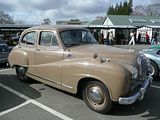
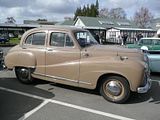
 Competitor to the A40 was the well known Morris Minor. Launched at the 1948 British Motor Show, this was Issigonis’ first world beating design and the car was popular when new and has never lost its appeal. There were far more Minors in attendance than anything else. Some were delightfully original, a few (which I could not bring myself to photograph) were mutilated beyond all belief.
Competitor to the A40 was the well known Morris Minor. Launched at the 1948 British Motor Show, this was Issigonis’ first world beating design and the car was popular when new and has never lost its appeal. There were far more Minors in attendance than anything else. Some were delightfully original, a few (which I could not bring myself to photograph) were mutilated beyond all belief.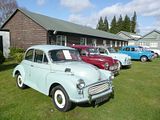
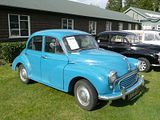

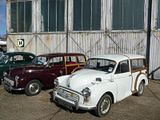
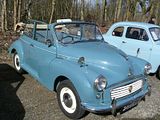
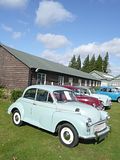
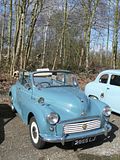

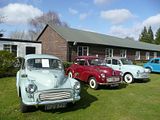
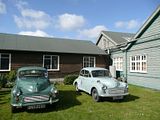 The Minor was popular not just as a saloon (2 and 4 door), Traveller (estate) and Convertible (Tourer), but also as a van and a pickup, and several of these were also on display.
The Minor was popular not just as a saloon (2 and 4 door), Traveller (estate) and Convertible (Tourer), but also as a van and a pickup, and several of these were also on display.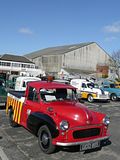
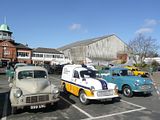
 The Minor name was not being used for the first time with this car, as it had also seen service nearly 20 years earlier with Morris’ cheap car offering for the recessionary early 1930s, and here is one such car.
The Minor name was not being used for the first time with this car, as it had also seen service nearly 20 years earlier with Morris’ cheap car offering for the recessionary early 1930s, and here is one such car.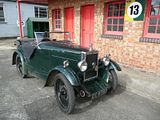
 Looking like a slightly enlarged Minor was the larger Oxford MO Series. These cars are rare now, as all the interest is on their smaller brother.
Looking like a slightly enlarged Minor was the larger Oxford MO Series. These cars are rare now, as all the interest is on their smaller brother.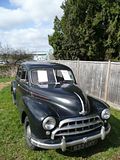
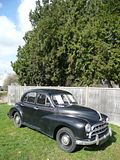 Austin had an answer to the Minor, it was called the A30 and it was launched in 1952. The more powerful A35 arrived in 1956, and 2 door, 4 door and Countryman (estate) and Van versions were offered. Not as roomy inside as the Minor, and not as good to drive (I am told – I’ve never driven either, but I did used to go to school in a Minor!), this little car has its followers now, too.
Austin had an answer to the Minor, it was called the A30 and it was launched in 1952. The more powerful A35 arrived in 1956, and 2 door, 4 door and Countryman (estate) and Van versions were offered. Not as roomy inside as the Minor, and not as good to drive (I am told – I’ve never driven either, but I did used to go to school in a Minor!), this little car has its followers now, too. 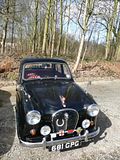
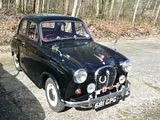
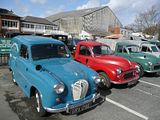
 Back in post war Britain, small utility vehicles were needed, as the country slowly got back on its feet. This Morris J Van is typical of the sort of offering. Great fun now, one look at the primitive conditions inside, with seats that would barely support even the middle of your back and a truly puny engine make me grateful for growing up when I did and not being 30 years older! This one is restored in GPO (Telephones) Livery, which was dark green, to distinguish it from the GPO (mail) vans which were scarlet. Marvellous.
Back in post war Britain, small utility vehicles were needed, as the country slowly got back on its feet. This Morris J Van is typical of the sort of offering. Great fun now, one look at the primitive conditions inside, with seats that would barely support even the middle of your back and a truly puny engine make me grateful for growing up when I did and not being 30 years older! This one is restored in GPO (Telephones) Livery, which was dark green, to distinguish it from the GPO (mail) vans which were scarlet. Marvellous.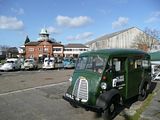
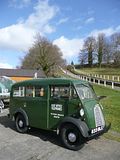 Austin and Morris came together in 1952, to form BMC. It was not long after this that the badge engineered models started appearing. With Morris came MG, Wolseley and Riley. Not all models appeared with all 5 badges, though in time that did happen. Before that was the case, the mid 50s sport saloon (the 3 series of its day, if you like!) came out in sporting version, like this MG Magnette ZA, and a more luxurious version, the Wolseley 15/50.
Austin and Morris came together in 1952, to form BMC. It was not long after this that the badge engineered models started appearing. With Morris came MG, Wolseley and Riley. Not all models appeared with all 5 badges, though in time that did happen. Before that was the case, the mid 50s sport saloon (the 3 series of its day, if you like!) came out in sporting version, like this MG Magnette ZA, and a more luxurious version, the Wolseley 15/50.
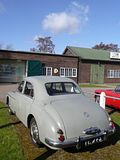
 It was the launch, in 1959, of the Farina-based mid sized cars where badge engineering was first exploited to the full, with all 5 brands having a car. Riley was the top of the tree, with MG the sporting car, Wolseley the luxury one and Austin and Morris, with the Cambridge and Oxford battling it out against each other. The first cars had the fashionable rear fins, but a facelift in 1962, which brought a more powerful and larger engine smoothed them out. My father had 2 Series VI Morris Oxfords, the second of which (CCC651D) was even in the same Rose Taupe with a white roof as one of these cars. They were heavy cars to drive and my mother could not get the handbrake on and off and abandoned learning to drive til the much lighter Hillman Hunter arrived in the family replace the Oxford!
It was the launch, in 1959, of the Farina-based mid sized cars where badge engineering was first exploited to the full, with all 5 brands having a car. Riley was the top of the tree, with MG the sporting car, Wolseley the luxury one and Austin and Morris, with the Cambridge and Oxford battling it out against each other. The first cars had the fashionable rear fins, but a facelift in 1962, which brought a more powerful and larger engine smoothed them out. My father had 2 Series VI Morris Oxfords, the second of which (CCC651D) was even in the same Rose Taupe with a white roof as one of these cars. They were heavy cars to drive and my mother could not get the handbrake on and off and abandoned learning to drive til the much lighter Hillman Hunter arrived in the family replace the Oxford!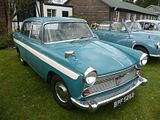

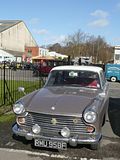
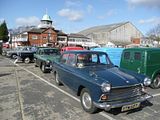 The larger cars in the range were also Farina styled, but this time more obviously different, and limited to the A99 (later A110) Westminster and Wolseley 6/99 (later 6/110). These cars are both from the later series of Wolseley, and the Westminster is an A110.
The larger cars in the range were also Farina styled, but this time more obviously different, and limited to the A99 (later A110) Westminster and Wolseley 6/99 (later 6/110). These cars are both from the later series of Wolseley, and the Westminster is an A110.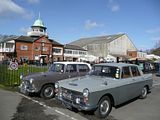
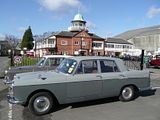
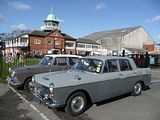
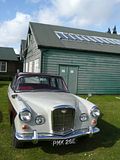
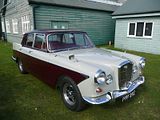
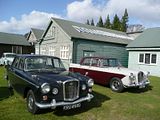 Leonard Lord, at Austin, was so impressed with the Healey design he saw that he arranged to take responsibility for making and selling the car. Announced in 1952 as the Austin Healey 100, over many years, this car was an instant success, not least in America, and evolved into the long lived 3000 model that was on sale until 1967. The sole example of what is now called the Big Healey was this 100 model from the mid 1950s.
Leonard Lord, at Austin, was so impressed with the Healey design he saw that he arranged to take responsibility for making and selling the car. Announced in 1952 as the Austin Healey 100, over many years, this car was an instant success, not least in America, and evolved into the long lived 3000 model that was on sale until 1967. The sole example of what is now called the Big Healey was this 100 model from the mid 1950s.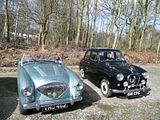
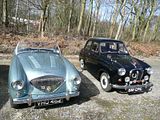 In 1958, a smaller brother, the Sprite arrived, and one of these arrived, too, with the roof down so the driver could take advantage of the spring sunshine.
In 1958, a smaller brother, the Sprite arrived, and one of these arrived, too, with the roof down so the driver could take advantage of the spring sunshine.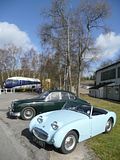 In 1964, the intended replacement for the Farina cars arrived, the Austin 1800 (code named ADO17). This was the third in a trio of very space efficient Issigonis designs, but it never had the same success as the smaller models. Early cars were very basic inside (deliberately so), and that was part of the problem. They had acres of space in them, and with the now famous 1798cc B Series engine, they went well. Success in rallying proved that they were tough, but despite all the various changes and upgrades, they never really sold that well. This is an Austin 1800 Series 2 from 1970.
In 1964, the intended replacement for the Farina cars arrived, the Austin 1800 (code named ADO17). This was the third in a trio of very space efficient Issigonis designs, but it never had the same success as the smaller models. Early cars were very basic inside (deliberately so), and that was part of the problem. They had acres of space in them, and with the now famous 1798cc B Series engine, they went well. Success in rallying proved that they were tough, but despite all the various changes and upgrades, they never really sold that well. This is an Austin 1800 Series 2 from 1970.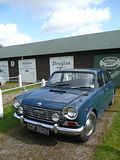 After the Minor, Issigonis next made his name with the Mini. Launched in 1959 as the Austin Se7en and Morris Mini Minor, the oldest of these cars will be 50 in 2009, and we will see all sorts of celebratory events to mark the occasion. Just one of the early models, with long wand of a gear change, and floor mounted starter button was on show.
After the Minor, Issigonis next made his name with the Mini. Launched in 1959 as the Austin Se7en and Morris Mini Minor, the oldest of these cars will be 50 in 2009, and we will see all sorts of celebratory events to mark the occasion. Just one of the early models, with long wand of a gear change, and floor mounted starter button was on show. 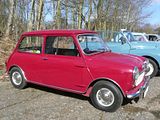
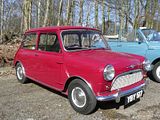
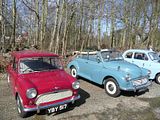 The next car that was launched, following the same philosophy was ADO16, which first appeared in 1962, as the Morris 1100. This car also spawned a full range of derivatives, including the ultra-luxury Vanden Plas version. For many years it was Britain’s best selling car, but terminal rust has wiped out all but a few. When we first got a second car, we had a (very secondhand) Connaught Green Morris 1100 Series 2, and I remember it as being supremely comfortable, and with plenty of space in it (mind you, my brother and I were very small kids at the time!). It was replaced by a Mini, for which I never had the same affection, even though late in its life with us, it was the car I learned to drive in. As well as some rare estate models, two of the display cars were the very rare Automatic models. These cars had a very ingenious 4 speed Automotive Products auto transmission, which was a miracle of packaging given the in-sump gear layout that Issigonis had designed (to save space), which in later years simply precluded adding a fifth speed to the manual gearbox!
The next car that was launched, following the same philosophy was ADO16, which first appeared in 1962, as the Morris 1100. This car also spawned a full range of derivatives, including the ultra-luxury Vanden Plas version. For many years it was Britain’s best selling car, but terminal rust has wiped out all but a few. When we first got a second car, we had a (very secondhand) Connaught Green Morris 1100 Series 2, and I remember it as being supremely comfortable, and with plenty of space in it (mind you, my brother and I were very small kids at the time!). It was replaced by a Mini, for which I never had the same affection, even though late in its life with us, it was the car I learned to drive in. As well as some rare estate models, two of the display cars were the very rare Automatic models. These cars had a very ingenious 4 speed Automotive Products auto transmission, which was a miracle of packaging given the in-sump gear layout that Issigonis had designed (to save space), which in later years simply precluded adding a fifth speed to the manual gearbox!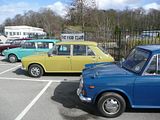
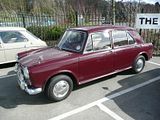
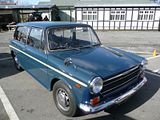
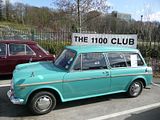
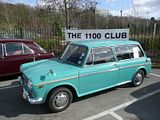 After that, it all went downhill, really. There was the Morris Marina. Launched in 1971, as an attempt to compete directly with the ever more successful Ford Cortina, it never got close. This car was a Series 2 fitted with the then new O Series engine, in 1700cc form (even that was odd, as no-one had engines of that size). A couple of Marina coupes turned up, but they eluded my camera. Late in its life, there was a styling make over and the name changed to Ital, and this van was a reminder of that period.
After that, it all went downhill, really. There was the Morris Marina. Launched in 1971, as an attempt to compete directly with the ever more successful Ford Cortina, it never got close. This car was a Series 2 fitted with the then new O Series engine, in 1700cc form (even that was odd, as no-one had engines of that size). A couple of Marina coupes turned up, but they eluded my camera. Late in its life, there was a styling make over and the name changed to Ital, and this van was a reminder of that period.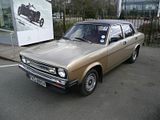
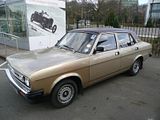

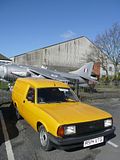 In 1975, the Austin-Morris 18-22 Series was launched. A bold design indeed, it also never achieved the success it could have done. Later models with the O Series engine and more things to go wrong were hardly the paragon of reliability, which did not help matters. A few of them have survived and were on show here.
In 1975, the Austin-Morris 18-22 Series was launched. A bold design indeed, it also never achieved the success it could have done. Later models with the O Series engine and more things to go wrong were hardly the paragon of reliability, which did not help matters. A few of them have survived and were on show here.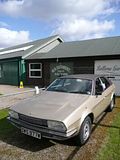
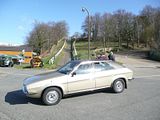
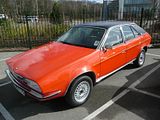
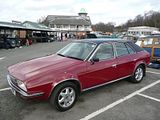 I’ve left the very “best” til last. This splendid A90 Atlantic is a rare beast indeed. Intended to appeal to the American market, as an alternative to their home-produced convertibles, this heavy, ugly (?), and underpowered device struggled to make any sales headway at all. The open top model was followed up by a fixed head coupe, but that did no better. Only about 8000 of these cars were made between 1949 and 1952, so they were rare when new and they are incredibly rare now. Although this one was not absolutely mint, it was in pretty good condition, and the owner had proudly parked it right by the entrance and with the famous Brooklands test hill in the background. Marvellous nostalgia indeed!
I’ve left the very “best” til last. This splendid A90 Atlantic is a rare beast indeed. Intended to appeal to the American market, as an alternative to their home-produced convertibles, this heavy, ugly (?), and underpowered device struggled to make any sales headway at all. The open top model was followed up by a fixed head coupe, but that did no better. Only about 8000 of these cars were made between 1949 and 1952, so they were rare when new and they are incredibly rare now. Although this one was not absolutely mint, it was in pretty good condition, and the owner had proudly parked it right by the entrance and with the famous Brooklands test hill in the background. Marvellous nostalgia indeed!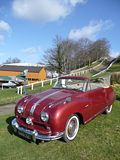
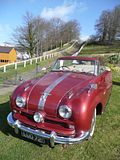
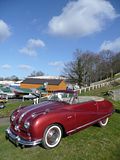
 Looking at my pictures, I realise that somehow I managed to avoid photos of many of the Austin Sevens, all the A40 Farina cars (there were only a few there and they left early), a few Mini Coopers (none of which were very original), most of the Farinas (they were close together with terrible shadow issues!) and most sadly, one of those real “lemons”, the Austin 3 litre. This was a stretched 1800, with the 3 litre 6 cylinder engine under the bonnet. It had a troubled birth, with a relaunch a year after its first Earls Court Show appearance, and it was on the market for barely 3 years, selling less than 10,000 cars. The one on display, in burgundy, was H plated, so one of the last ones, and when viewed close up had terrible bubbling on every single panel. Restoring it would cost far more than the car is worth, but I do hope it does not have a one-way trip to the recycler.
Looking at my pictures, I realise that somehow I managed to avoid photos of many of the Austin Sevens, all the A40 Farina cars (there were only a few there and they left early), a few Mini Coopers (none of which were very original), most of the Farinas (they were close together with terrible shadow issues!) and most sadly, one of those real “lemons”, the Austin 3 litre. This was a stretched 1800, with the 3 litre 6 cylinder engine under the bonnet. It had a troubled birth, with a relaunch a year after its first Earls Court Show appearance, and it was on the market for barely 3 years, selling less than 10,000 cars. The one on display, in burgundy, was H plated, so one of the last ones, and when viewed close up had terrible bubbling on every single panel. Restoring it would cost far more than the car is worth, but I do hope it does not have a one-way trip to the recycler. An interesting event – for me at least – though I have to say that looking around the participants and attendees, I was definitely way under the average age. By a good 20 or 30 years, I’d say. Not only were many of the cars ones which had spent a lot of time either in one family, or sat idle in a garage for 20 years or so, it is clear that the cars were ones that appealed in many cases to their owners when both were much younger. Does that mean that in 2030, we will be reading an event about a gathering of Fiesta, Focus, Mondeos and the like that my contemporaries and I will have treasured away or lovingly restored?
2009-11-29 04:59:17


















































































